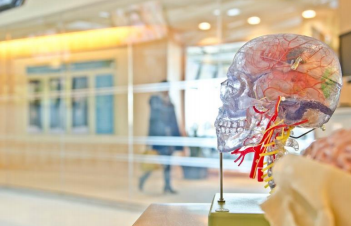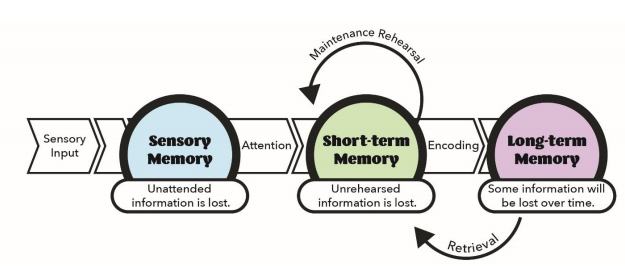14.4: Information Processing Theory- Memory, Encoding, and Storage
- Last updated
- Save as PDF
- Page ID
- 105572

Memory
Memory is an information processing system that we often compare to a computer. Memory is the set of processes used to encode, store, and retrieve information over different periods of time.

Encoding involves the input of information into the memory system. Storage is the retention of the encoded information. Retrieval, or getting the information out of memory and back into awareness, is the third function.
Encoding (Input of Information to Memory)
We get information into our brains through a process called encoding, which is the input of information into the memory system. Once we receive sensory information from the environment, our brains label or code it. We organize the information with other similar information and connect new concepts to existing concepts. Encoding information occurs through both automatic processing and effortful processing. For example, if someone asks you what you ate for lunch today, more than likely you could recall this information quite easily. This is known as automatic processing, or the encoding of details like time, space, frequency, and the meaning of words. Automatic processing is usually done without any conscious awareness.
Recalling the last time you studied for a test is another example of automatic processing. But what about the actual test material you studied? It probably required a lot of work and attention on your part to encode that information; this is known as effortful processing. When you first learn new skills such as driving a car, you have to put forth effort and attention to encode information about how to start a car, how to brake, how to handle a turn, and so on. Once you know how to drive, you can encode additional information about this skill automatically.
Storage (Retaining Information in Memory)
Once the information has been encoded, we have to retain it. Our brains take the encoded information and place it in storage. Storage is the creation of a permanent record of information. In order for a memory to go into storage (i.e., long-term memory), it has to pass through three distinct stages: Sensory Memory, Short-Term Memory, and finally Long-Term Memory. These stages were first proposed by Richard Atkinson and Richard Shiffrin (1968). Their model of human memory, called Atkinson-Shiffrin (A-S), is based on the belief that we process memories in the same way that a computer processes information.

Sensory Memory (First Stage of Storage)
In the Atkinson-Shiffrin model, stimuli from the environment are processed first in sensory memory, storage of brief sensory events, such as sights, sounds, and tastes. It is very brief storage—up to a couple of seconds. We are constantly bombarded with sensory information. We cannot absorb all of it, or even most of it. And most of it has no impact on our lives. For example, what was your professor wearing the last class period? As long as the professor was dressed appropriately, it does not really matter what they were wearing. Sensory information about sights, sounds, smells, and even textures, which we do not view as valuable information, we discard. If we view something as valuable, the information will move into our short-term memory system.
One study of sensory memory researched the significance of valuable information on short-term memory storage. J. R. Stroop discovered a memory phenomenon in the 1930s: you will name a color more easily if it appears printed in that color, which is called the Stroop effect.
The Stroop Effect describes why it is difficult for us to name a color when the word and the color of the word are different. To test this out a person is instructed not to read the words below, but to say the color the word is printed in. For example, upon seeing the word “yellow” in green print, they should say “green,” not “yellow.” This experiment is fun, but it’s not as easy as it seems.

Short-Term Memory or Working Memory (Second Stage of Storage)
Short-term memory is a temporary storage system that processes incoming sensory memory; sometimes it is called working memory. Short-term memory takes information from sensory memory and sometimes connects that memory to something already in long-term memory. Short-term memory storage lasts about 20 seconds. Think of short-term memory as the information you have displayed on your computer screen—a document, a spreadsheet, or a web page. Information in short-term memory either goes to long-term memory (when you save it to your hard drive) or it is discarded (when you delete a document or close a web browser).
George Miller (1956), in his research on the capacity of memory, found that most people can retain about seven items in short-term memory. Some remember five, some nine, so he called the capacity of short-term memory the range of seven items plus or minus two.
To explore the capacity and duration of short-term memory, two people can try this activity. One person reads the strings of random numbers below out loud to the other, beginning each string by saying, “Ready?” and ending each by saying, “Recall.” Then the second person should try to write down the string of numbers from memory.

This can be used to determine the longest string of digits that you can store. For most people, this will be close to seven, Miller’s famous seven plus or minus two. Recall is somewhat better for random numbers than for random letters (Jacobs, 1887) and is also often slightly better for information we hear (acoustic encoding, which is the encoding of sounds) rather than what we see (visual encoding, which is the encoding of images and words in particular) (Anderson, 1969).
Long-Term Memory (Third and Final Stage of Storage)
Long-term memory is the continuous storage of information. Unlike short-term memory, the storage capacity of long-term memory has no limits. It encompasses all the things you can remember that happened more than just a few minutes ago to all of the things that you can remember that happened days, weeks, and years ago. In keeping with the computer analogy, the information in your long-term memory would be like the information you have saved on the hard drive. It isn’t there on your desktop (your short-term memory), but you can pull up this information when you want it, at least most of the time. Not all long-term memories are strong memories. Some memories can only be recalled through prompts. For example, you might easily recall a fact— “What is the capital of the United States?”—or a procedure—“How do you ride a bike?”—but you might struggle to recall the name of the restaurant you had dinner at when you were on vacation in France last summer. A prompt, such as that the restaurant was named after its owner, who spoke to you about your shared interest in soccer, may help you recall (retrieve) the name of the restaurant.
Retrieval (Finding Memories)
So you have worked hard to encode via effortful processing (a lot of work and attention on your part in order to encode that information) and store some important information for your upcoming final exam. How do you get that information back out of storage when you need it? The act of getting information out of memory storage and back into conscious awareness is known as retrieval. This would be similar to finding and opening a paper you had previously saved on your computer’s hard drive. Now it’s back on your desktop, and you can work with it again. Our ability to retrieve information from long-term memory is vital to our everyday functioning. You must be able to retrieve information from memory in order to do everything from knowing how to brush your hair and teeth, to driving to work, to knowing how to perform your job once you get there.
Long-Term Memory Retrieval (Storage System): Recall, Recognition, Relearning, and Forgetting
There are three ways you can retrieve information out of your long-term memory storage system: recall, recognition, and relearning. Recall is what we most often think about when we talk about memory retrieval: it means you can access information without cues. For example, you would use recall for an essay test. Recognition happens when you identify information that you have previously learned after encountering it again. It involves a process of comparison. When you take a multiple-choice test, you are relying on recognition to help you choose the correct answer. The third form of retrieval is relearning, and it’s just what it sounds like, it involves learning information that you previously learned. Whitney took Spanish in high school, but after high school she did not have the opportunity to speak Spanish. Whitney is now 31, and her company has offered her an opportunity to work in their Mexico City office. In order to prepare herself, she enrolls in a Spanish course at the local community college. She’s surprised at how quickly she’s able to pick up the language after not speaking it for 13 years; this is an example of relearning.
Forgetting (It Wasn’t Locked In)
As we just learned, your brain must do some work (effortful processing) to encode information and move it into short-term, and ultimately long-term memory. This has strong implications for a student, as it can impact their learning – if one doesn’t work to encode and store information, it will likely be forgotten. Research indicates that people forget 80 percent of what they learn only a day later. This statistic may not sound very encouraging, given all that you’re expected to learn and remember as a college student. Really, though, it points to the importance of a study strategy other than waiting until the night before a final exam to review a semester’s worth of readings and notes. When you learn something new, the goal is to “lock it in” sooner rather than later, and move it from short-term memory to long-term memory, where it can be accessed when you need it (like at the end of the semester for your final exam or maybe years from now). The next section will explore a variety of strategies that can be used to process information more deeply and help improve retrieval. 18
Memory Strategies 19
Knowing What to Know How can you decide what to study and what you need to know? The answer is to prioritize what you’re trying to learn and memorize, rather than trying to tackle all of it. Below are some strategies to help you do this:
- Think about concepts rather than facts: Most of the time instructors are concerned about you learning about the key concepts in a subject or course rather than specific facts.
- Take cues from your instructor: Pay attention to what your instructor writes on the board, mentions repeatedly in class, or includes in study guides and handouts, they are likely core concepts that you’ll want to focus on.
- Look for key terms: Textbooks will often put key terms in bold or italics.
- Use summaries: Read end of chapter summaries, or write your own, to check your understanding of the main elements of the reading.
Transferring Information from Short-Term Memory to Long-Term Memory In the previous discussion of how memory works, the importance of making intentional efforts to transfer information from short-term to long-term memory was noted. Below are some strategies to facilitate this process:
- Start reviewing new material immediately: Remember that people typically forget a significant amount of new information within 24 hours of learning it.
- Study frequently for shorter periods of time: If you want to improve the odds of recalling course material by the time of an exam or in future class, try reviewing it a little bit every day.
Strengthening your Memory How can you work to strengthen your overall memory? Some people have stronger memories than others but memorizing new information takes work for anyone. Below are some strategies that can aid memory:
- Rehearsal: One strategy is rehearsal, or the conscious repetition of information to be remembered (Craik & Watkins, 1973). Academic learning comes with time and practice, and at some point the skills become second nature.
- Incorporate visuals: Visual aids like note cards, concept maps, and highlighted text are ways of making information stand out. These aids make the information to be memorized seem more manageable and less daunting.
- Create mnemonics: Memory devices known as mnemonics can help you retain information while only needing to remember a unique phrase or letter pattern that stands out. They are especially useful when we want to recall larger bits of information such as steps, stages, phases, and parts of a system (Bellezza, 1981). There are different types of mnemonic devices:
- Acronym: An acronym is a word formed by the first letter of each of the words you want to remember. Such as HOMES for the Great Lakes (Huron, Ontario, Michigan, Erie, and Superior)
- Acrostic: In an acrostic, you make a phrase of all the first letters of the words. For example, if you need to remember the order of mathematical operations, recalling the sentence “Please Excuse My Dear Aunt Sally” will help you, because the order of mathematical operations is Parentheses, Exponents, Multiplication, Division, Addition, Subtraction.
- Jingles: Rhyming tunes that contain key words related to the concept, such as “i before e, except after c” are jingles.
- Visual: Using a visual to help you remember is also useful. Such as the knuckle mnemonic shown in the image below to help you remember the number of days in each month. Months with 31 days are represented by the protruding knuckles and shorter months fall in the spots between knuckles.

- Chunking: Another strategy is chunking, where you organize information into manageable bits or chunks, such as turning a phone number you remember into chunks.
- Connect new information to old information: It’s easier to remember new information if you can connect it to old information, a familiar frame of reference, or a personal experience.
- Get quality sleep: Although some people require more or less sleep than the recommended amount, most people should aim for six to eight hours every night.
Contributors and Attributions
18. Memory and Information Processing by Laura Lucas is licensed under CC BY 4.0
19. Memory and Information Processing by Laura Lucas is licensed under CC BY 4.0


